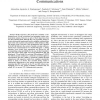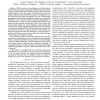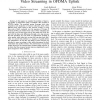PIMRC
2015
IEEE
8 years 9 months ago
2015
IEEE
Abstract—Radio frequency (RF) front-ends constitute a fundamental part of both conventional and emerging wireless communication systems. However, in spite of their importance the...
PIMRC
2015
IEEE
8 years 9 months ago
2015
IEEE
—Inter-cell interference problems arise in dense frequency reuse networks such as Long Term Evolution (LTE). They have harmful impact on system performance, especially for cell-e...
PIMRC
2015
IEEE
8 years 9 months ago
2015
IEEE
—Opportunistic interference alignment (OIA) exploits channel randomness and multiuser diversity by user selection. The transmitter needs channel state information (CSI), which is...
PIMRC
2015
IEEE
8 years 9 months ago
2015
IEEE
—With the advent of next-generation mobile devices, wireless networks must be upgraded to fill the gap between huge user data demands and scarce channel capacity. Mm-waves techn...
PIMRC
2015
IEEE
8 years 9 months ago
2015
IEEE
—The fading process describing the propagation effects caused by scattering between two mobile transceivers shows strong non-stationary properties. For its characterization the l...
PIMRC
2015
IEEE
8 years 9 months ago
2015
IEEE
—The growing number of network mechanisms results in a large amount of data flow processing to be performed in future wireless access networks. Determining suitable locations fo...
PIMRC
2015
IEEE
8 years 9 months ago
2015
IEEE
Abstract—In this paper, we derive closed-form capacity expressions for a low complexity bit-interleaved coded modulation system with uniform inputs in a Rayleigh fading channel w...
PIMRC
2015
IEEE
8 years 9 months ago
2015
IEEE
—The problem of efficient decoding of polar codes is considered. A multilevel bucket structure is proposed for implementation of the stack in the sequential decoding algorithm. ...
PIMRC
2015
IEEE
8 years 9 months ago
2015
IEEE
Abstract—This paper considers the cooperation between primary and secondary users at information and energy levels when both users are energy harvesting nodes. In particular, a s...
PIMRC
2015
IEEE
8 years 9 months ago
2015
IEEE
Abstract—In this paper, we consider the problem of improving Quality of Experience (QoE) of multiple video streams in OFDMA uplink. The proposed system leverages both video adapt...



